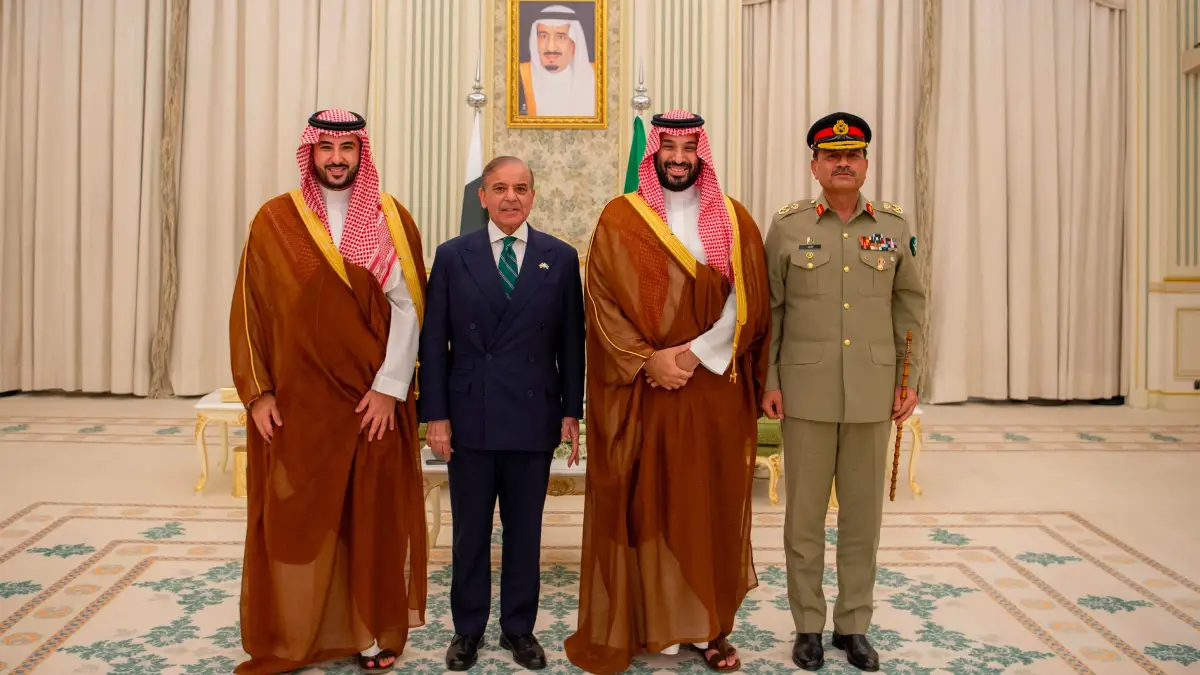India has reacted with a measured stance, saying it will assess how the Pakistan–Saudi Strategic Mutual Defence Agreement affects national security and regional stability, while robust India–Saudi ties make immediate alarm unlikely based on current signals from both sides. New Delhi has emphasized it remains committed to safeguarding national interests and ensuring comprehensive security across all domains as it studies the pact’s implications.
Pact at a glance
Pakistan and Saudi Arabia have signed the Strategic Mutual Defence Agreement in Riyadh during Prime Minister Shehbaz Sharif’s visit, attended by Crown Prince Mohammed bin Salman and Pakistan’s army chief Field Marshal Asim Munir (Reuters). The accord includes a Nato-like clause stating that any aggression against one will be treated as aggression against both, and frames cooperation as strengthening joint deterrence and regional peace. Saudi officials say the pact institutionalises long-standing cooperation and is not a reaction to any specific country or recent events.
Context and timing
The signing followed Sharif’s participation in an OIC Arab-Islamic summit in Doha after Israel’s strike on Hamas leaders in Qatar amid ceasefire discussions over Gaza. It also comes after India’s May “Operation Sindoor,” a response to the April Pahalgam terror attack that killed 26 people, in which India struck terror targets inside Pakistan, including deep into its territory.
Security ties so far
Pakistan and Saudi Arabia have cooperated closely for decades without a formal treaty, with Islamabad having trained more than 8,200 Saudi personnel since 1967 and both sides conducting regular joint exercises. Riyadh has been a key oil supplier and financial supporter for Pakistan over many years, underpinning the relationship’s depth.
Military balance snapshot
- Defence budgets: Saudi Arabia and India are each at about $78.3 billion, while Pakistan’s is about $9 billion, reflecting very different resource bases.
- Defence spend share of GDP: Saudi Arabia around 7 percent, Pakistan about 3.8 percent, and India near 1.9 percent.
- Global Firepower 2025 ranks: India 4th, Pakistan 12th, Saudi Arabia 24th.
- Personnel: India ~1.4 million active and ~1.15 million reserves; Pakistan ~654,000 active and ~550,000 reserves; Saudi Arabia ~257,000 active and no reserves.
- Paramilitary: India ~2.5 million; Pakistan ~291,000; Saudi Arabia ~150,000.
Air, land, sea, and nukes
- Fighters: India ~513; Pakistan ~328; Saudi Arabia ~283, with Pakistan pursuing air force modernisation as concerns persist about IAF squadron strength trends.
- Armour: India ~4,200 tanks; Pakistan ~2,627; Saudi Arabia ~840, alongside light armoured vehicles and armoured carriers.
- Naval carriers: India fields two INS Vikrant and INS Vikramaditya while Pakistan and Saudi Arabia have none.
- Nuclear status: India and Pakistan possess nuclear weapons; Saudi Arabia does not, with Pakistan the only Islamic state with a nuclear arsenal.
India–Saudi ties
Bilateral ties date back to 1947 and were elevated to a strategic partnership in 2010, with engagement deepening through high-level visits, including Prime Minister Narendra Modi’s trips in 2016, 2019, and 2025, and Crown Prince Mohammed bin Salman’s 2019 visit that announced $100 billion in planned investment and multiple MoUs. Trade reached $42.98 billion in FY 2023–24, with India as Saudi Arabia’s second-largest trading partner and Saudi Arabia as India’s fifth-largest, while defence ties include two ‘Al Mohed Al Hindi’ naval exercises, the 2024 ‘Ex-Sada Tanseeq I’ land exercise, and a $225 million Munitions India Ltd export deal. Saudi officials say they aim to balance relations and continue deepening cooperation with India, which Riyadh strongly backed after the Pahalgam attack, sending its foreign minister to New Delhi following Operation Sindoor.
India’s response
The Ministry of External Affairs has said it was aware the pact formalises a long-considered arrangement and will “study the implications” for national security and regional and global stability, underscoring a commitment to comprehensive security in all domains. While questions were raised about a “nuclear umbrella,” a Saudi official described the accord as a comprehensive defensive agreement across military means, and the current trajectory of India–Saudi ties suggests limited cause for alarm from New Delhi’s perspective.
With inputs from agencies.
